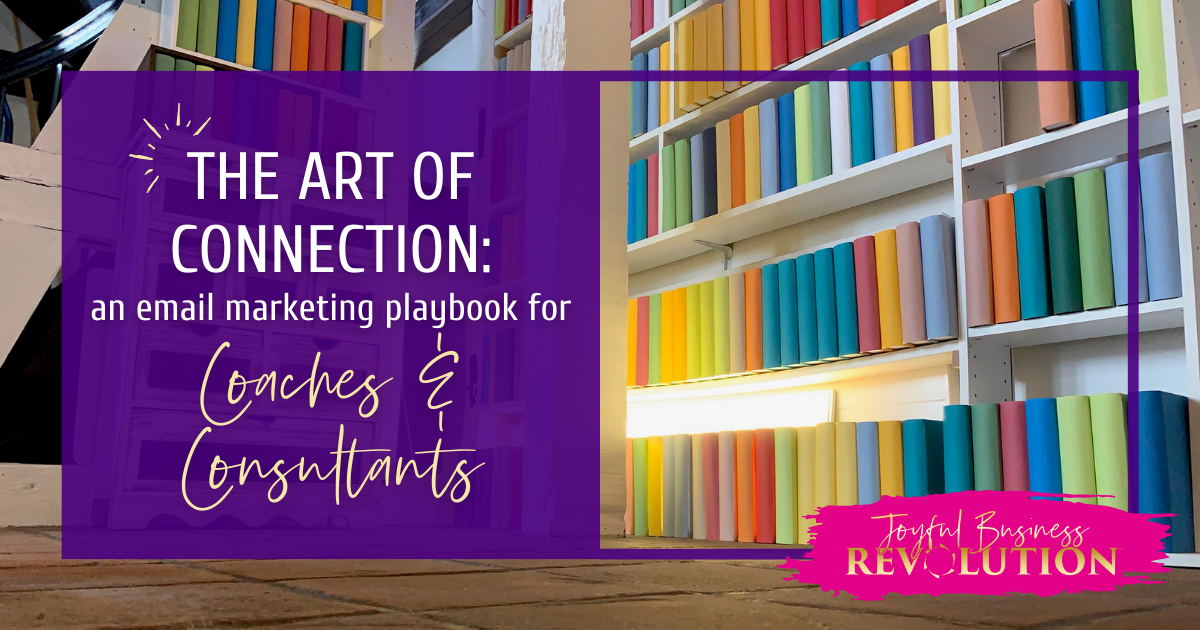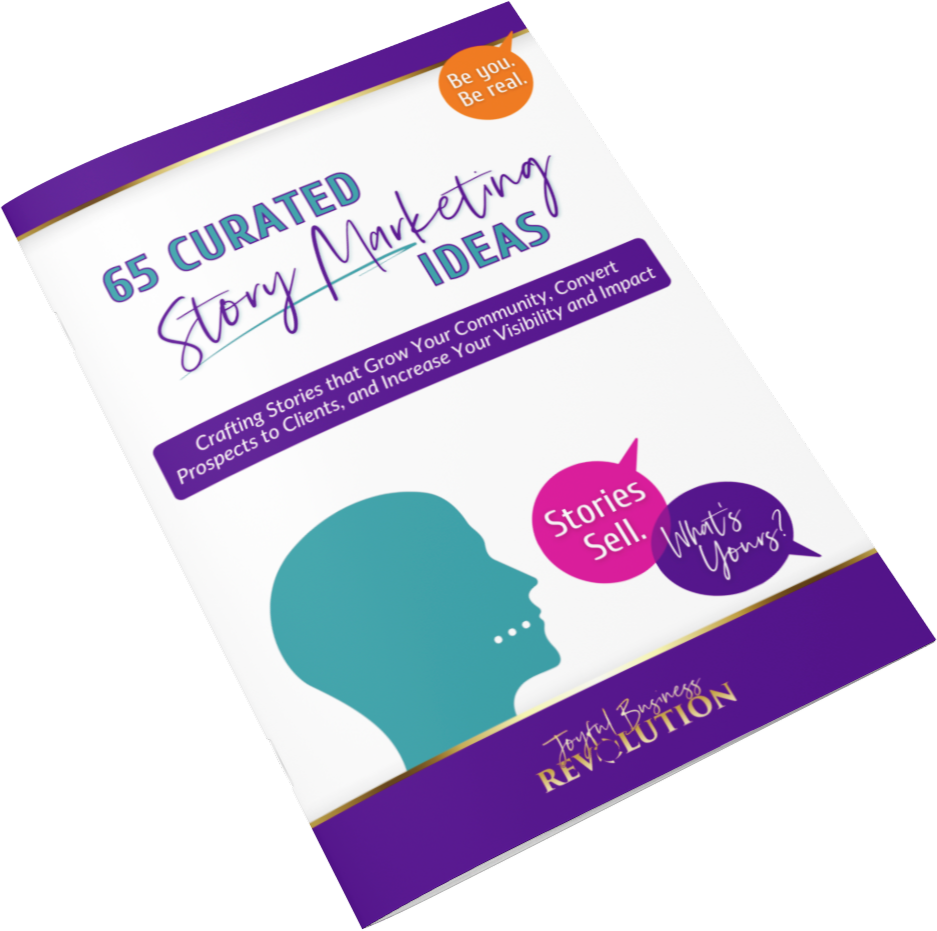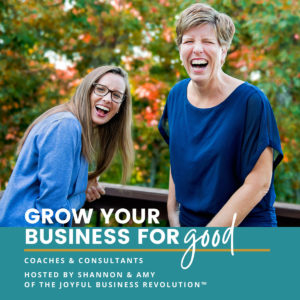
As an Organic Marketing Strategist and Business Growth Consultant who has grown a thriving business over the past 13 years through the power of deepening relationships that result in more revenue, I can say this with 100% certainty:
- Email marketing is my LOVE language.
- Email marketing keeps my nervous system calm.
- Email marketing keeps me from needing to rely on social media for “finding” clients.
- Email marketing has helped me build a sustainable business rooted in relationships and community-building.
I’ve had the honor to help 1000s of coaches, consultants, and experts over the past decade tap into the power of growing, nurturing, and creating sales from their email list, simply by developing email campaigns and email newsletters that reach the hearts and minds of their subscribers and ideal clients.
You may be wondering if email marketing will work for your coaching business?
In my expertise, I can say with a resounding YES!–yes it WILL…
If you develop a digital marketing strategy where you prioritize your content creation and marketing around email list building, deepening relationships with your prospective coaching clients, and personalizing your stories and content to create marketing that moves people to take action.
Here are the various types of coaches, consultants, and experts I have served over the past 13 years:
- Life coaches
- Spiritual coaches
- Marketing coaches
- Health & wellness coaches
- Business growth coaches
- Human design coaches
- Speakers with a program or course to sell
- Authors with a program or course to sell
- Financial advisors
- Creativity course creators and coaches
- Publishers
- Ghostwriters
- Photographers
- Website designers
- Copywriters
- Memoir coaches
- Realtors
- Documentary and film makers
- Brick and mortar businesses: Chiropractors, architects, massage therapists, nutrition centers
- +many more!
So no matter your coaching speciality, your coaching niche, or your area of expertise, rest assured, email marketing WILL work to help you grow your coaching service, group coaching programs, or coaching classes.
And just for fun–and because I practice what I preach, I’m inviting you to join my email community by downloading the resource below–where we make marketing and business growth joyful and profitable!
Download 65 Curated Story Marketing Ideas so that have fun story marketing content prompts for your email marketing AND so you can see how to use email marketing in your own business.
(Warning: Only join me if you are all in for MORE joy and money in your business!)
Why email marketing for coaches?
Statistically, a “good” day on social media means 70% of your followers don’t see any of the content you are posting. If you are sinking most of your time into marketing on social media, you are most likely missing your most engaged and potential buyers.
But investing your time, energy, and marketing budget into growing your email list, so you can grow your coaching and consulting business? Smart, very smart.
Your email list provides direct access to your ideal coaching clients’ world. One of the things that excites me most about email marketing is everyone on your email list has ASKED to be there. They have given you PERMISSION to show up in their inboxes and share your expertise.
The work we do as coaches and consultants is deeply personal, and we know that it’s just as important for your clients to be a great fit for you, as well as for you the be a great-fit coach for them. Your email marketing helps potential clients grow that know, like, and trust factor, as well as stay top of mind. The more personal your storytelling can be in your communication with your future coaching clients, the more revenue you will make. Humans want to work with humans. Period.
When you use email marketing as the main form of communication with your community, you can count growing a sustainable, long-term, and successful coaching business:
- You own your contact data when people opt in to your email marketing list.
- You no longer have to chase algorithms or respond to whatever is hot and trendy and working on social media at the moment.
- You do not have to create any type of content you do not feel called to create–just to appease a social media trend or platform. Hate videos? Stop doing them. Want to host a podcast? Go for it! (Just be sure to tie the podcast into the email marketing strategy so all your content marketing is effective and working together.)
- You can focus on what really drives revenue–not follower count, or “going viral”, or engagement -but deepening relationships with the people who have given you their email addresses.
- Former and existing clients love hearing from us–like I said, the work we do is deeply personal. And when you consistently show up in their inboxes, you stay top of mind and they can forward and share your content with their friends.
Many social media marketing “experts” love to say “email marketing is dead.” Of course they do–telling you that will increase their sales and increase your fear, keeping you stuck in that social media hamster wheel.
But I’m here with some hard facts and stats. Email marketing is not dead, never has been dead, and will never die.
Why?
On average, email drives an ROI (return on investment) of $44 for every $1 spent on email marketing campaigns; whereas social media marketing ROI is $.24 for every $1 spent. (Yes, you read that right, 24 cents.) This makes email marketing one of the most cost-effective tools in your toolbox.
According to statistics from GetResponse, 77% of marketers have seen an increase in email engagement over the last 12 months, proof that personalization and custom content and communication work.
So despite what you may have heard about “email being dead” don’t believe everything you hear. There’s still plenty of life left in this tried-and-true strategy. If you’re looking for an effective way to reach your audience and maximize your ROI, consider reaching out to speak with me or my team about adding an email campaign into your overall marketing strategy.
The Playbook: An Email Marketing System Designed for Online Coaches
Let’s talk about the components of an email marketing system that coaches, consultants, and experts can implement, for sustainable business growth and consistent revenue.
Here’s a simple list to get you started if you want to start or fine-tune your email marketing efforts.
-
Create a lead magnet
A lead magnet is a valuable resource that your most ideal clients would be interested in. It should shed insight to a “top of mind” problem they are already aware of–but haven’t been successful at solving , yet. There 100s of types of lead magnets that coaches, consultants, and experts could create–but here are some of the most effective, high-converting lead magnets:
- Quizzes and Assessments – People love learning more about themselves–and quizzes and assessments do just this! The Content Personality® Quiz has actually been one of my longest running lead magnets to date–and you’ll see why when you take the 8 question quiz! The main insight for people who take the quiz: Which type of marketing is best for me?
- Video Library: Clever Girl Finance knows that her community wants to discuss financial topics, get their questions answered, and hear directly from financial experts.
- eBook: CVENT provides a valuable lead magnet called “Next-Level Webinars”. It’s practical and insightful.
- Case Studies: This is the perfect lead magnet to share content that tells your audience about a client success story.
- Checklists: Create a printable checklist so people can physically check off the item on the list as they complete it.
-
Create a landing page and opt-in form
Your lead magnet landing page has ONE job: invite people to download your resource (and as a result, they are now on your email marketing subscriber list! Woohoo!)
Remember, this page needs to be short and sweet. When you create a landing page for your lead magnet that is converting well, coaches and consultants should see lead magnet optin rates at 30% or higher.
Here are the 5 parts of a high-converting lead magnet or optin landing page.- Pull Statement (a question or statement that pulls the person in)
- Title of Resource – best if this is in form of a graphic/image that catches the eye
- Benefits of the resources they want to download
- CTA (call to action)
- Optin Box – at a minimum, two fields: Name and Email
-
Tell people about it
There are countless easy ways to share your lead magnet with your audience –and this is where I DO BELIEVE the power is in social media.
- Last year we attracted nearly 2300 new email addresses and coaching client contacts to our list by sharing our resources in blog content and on social media. (This was all organic traffic – no paid ads were used to achieve these results.)
- You can also integrate a pop-up on your website to share you lead magnet, a “hello” bar with a call to action across the top of your website.
- Always share your lead magnet from virtual stages (podcasts and summits) as well as using a QR code when you are speaking at a live event.
- If you have lots of money to spare, you can drive paid traffic to your lead magnet with the use of ads.
-
Write your welcome sequence
The welcome sequence, also referred to as the nurture sequence, is a key component to getting new subscribers on your email list acquainted with your world, your business, your values, and the problems you can help them solve. After years of writing testing various types of nurture and welcome sequences, here are some best practices to keep in mind:
- 4-5 emails in your automated email sequence is enough. And you don’t need to send them all in one or two days either. Be kind to people – let them get to know you over the course of a week.
- Test your subject lines. Once you start getting some data for your lead magnet nurture sequence, it’s time to check in and see which emails have the highest open rates. Oftentimes, monitoring subject lines can lead to higher open rates.
- While looking at the data, it’s time to notice click through rates (CTRs). Are your new email subscribers clicking through to learn more about you, your offers, and your business?
- Have you personalized your welcome sequence? Where can you add more personalization to it? This is a great place to look at themed content and topics that resonate with your audience. Once again, small tweaks here can lead to big gains.
-
Write a sales sequence
Now that are attracting qualified leads to your email list, and they are starting to feel welcome and “at home” with you, your values, and your personality, let’s talk about how to create a sales sequence that invites interested prospects to explore coaching with you.
A sales sequence invites your email subscribers to take action and get help by paying you. Hence, sales! Please know this: If you are leery about making sales via email, you are not alone. This is one of the biggest hurdles I hve to help my clients with, initially. But once they get the hang of selling with story–and remaining HUMAN in their communication, both the money and their joy skyrockets.
I like to let my new subscribers go through the initial nurture sequence before they are moved on the main list–which is where I make offers about upcoming workshops, retreats, collaborations, and to work with me in my 1:1 business growth coaching program or in our messaging and marketing group coaching program.
The sky is the limit here in terms of how you can create an email marketing strategy that results in revenue–but remember, the most important thing to your email list subscribers is to provide value, education, and make offers. If you are only making offers, you’ll lose subscribers fast.
-
Begin writing regular emails and sending them to your list. I do recommend that you communicate with your email list once a week (minimum).
Remember this is a relationship we are nurturing here –like going on a date, or developing a new friendship. The HUMANS on your email list need to hear from you regularly–that’s where the know, like and trust marketing magic comes in!
If you have an email list that you haven’t communicated with in a while, no worries. We can develop a reactivation email campaign that is heartfelt and personal, and begin the relationship again to this “cold list”.
Frequently asked questions and answers about email marketing for coaches
Here are some common questions I am often asked as an email marketing coach about email marketing for coaches, consultants, and experts–that were not addressed above.
Question: What is a “good” open rate and a “good” click through rate in the coaching, consulting, and service-based industry?
Answer: You will learn that I am always WAY MORE interested in quality over quantity in all areas of marketing. This is not an exception. My goal would be for you to see email open rates at 40% and email click through rates higher than 5%. This of course would mean you are providing great content in your email marketing strategy–and have attracted the right audience to your email list.
Question: How big does my list need to be for an email marketing strategy to be effective?
Answer: Once again, quality over quantity. There is no list size requirement or rule for any of what I have shared here to work. (Well technically, you’ll need at least ONE person to communicate with to get data!)
Question: Should I buy email lists?
Answer: No. Buying email lists often results in low quality contacts and leads–and is illegal in many cases.
Question: What is a double opt-in? Should coaches, consultants, and experts use it?
Answer: A double optin is a measure that some coaches, consultants, and experts take to ensure that people do want to be on their email list. I find it completely unnecessary–and statistics show that those who use a single opt in have an 80% higher conversion rate to their email mailing or email newsletter list.
Question: What email marketing platform is best for coaches?
Answer: This is going to depend on many factors: your budget, your tech skills, do you want an EMS (email marketing system) that includes a CRM (customer relationship management) tool, etc. If you are just starting out with your email marketing journey, keep the platform simple.
Question: How often should I clean my email list –and why is this important?
Answer: I recommend cleaning your email content list every 90 days. You’ll be removing email addresses from those that have bounced, or those who are not opening emails in this time period. You want clean energy on your list–remember quality over quantity, always. Cleaning your email list ensures you get the most up to date data in terms of open rate, click through rate, and that your email deliverability score stays high.
Would you like to dive deeper into email marketing–and how to make it work better for your business?
Season 5 of our podcast, Grow Your Business for Good, is all about email marketing and a great next step–if you enjoy listening to podcasts packed with value–and JOY!
You can also read more in this series on Email Marketing for Coaches and Consultants. You can find the entire series linked below: –
- The Art of Connection: An Email Marketing Playbook for Coaches
- How I Use Email Marketing to Fill Every Seat for In-Person Events
- Email Marketing Mastery for Webinar Hosts: Tips, Tricks, and Sequences
- The Business Benefits of Newsletters (+ When to Be Wary)
- Lead Nurturing Email Sequences: The What, the Why, and the How
- Best Email Marketing Platform for Solopreneurs [2024]



